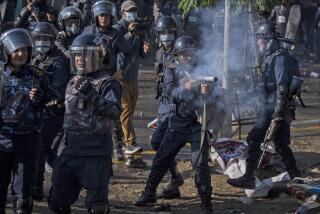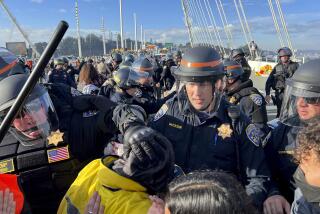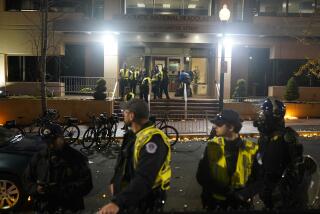Bahrain protesters clash with police
Police fired tear gas to disperse hundreds of anti-government demonstrators blocking access to the financial district Sunday morning, as sectarian tension escalated in this tiny island kingdom.
The clashes began early Sunday after protesters set up barricades across a main road into downtown Manama, the capital city, and turned away cars headed for work. Dozens of policemen in riot gear forced the demonstrators back in a series of clashes over two hours, eyewitnesses said.
The decision by several hundred demonstrators to block the road appeared to be an effort by some members of the opposition to broaden the protests and to escalate the pressure on the government. But there were also signs of growing sectarian strains, as a group of Shiite Muslim protesters clashed with Sunnis armed with sticks at Bahrain University, witnesses said.
The island kingdom, home to the headquarters of the U.S. Navy’s 5th Fleet, has seen weeks of demonstrations led by the Shiite opposition, which says it is discriminated against by the Sunni royal family.
Despite the growing tensions, the protest movement in Bahrain remains deeply split and so far unwilling to take up the government’s offer for talks to resolve its grievances.
The confrontations Sunday were among the most violent since the military killed seven protesters on Feb. 17. They followed similar clashes Friday when security forces fired what protesters said were rubber bullets and pro-government gangs armed with sticks beat back several hundred protesters near the royal palace in the neighborhood of Riffa.
When word of the confrontation near the financial district spread, dozens more young men joined the barricades and fought a running battle with police, witnesses said, before falling back to Pearl roundabout, the traffic circle occupied by protesters last month.
“We made a human wall, and they attacked us,” said Jafar al Mosaed, who said he was heading to his job at the local American Express office before parking his car and joining the protests. “We retreated, and they attacked us again.”
Several protesters warned Sunday that the government was deliberately fomenting sectarian tensions, in part to stoke fear that Shiite-dominated Iran would benefit if demands for greater political power by the protesters in Bahrain were met.
“They want people to believe there is a Sunni-Shia divide. The government is trying to scare the rest of the world,” said Muhammad Halwachi, a protester in Pearl roundabout.
There have been growing sectarian clashes in schools and streets in recent days, and rumors that shops owned by Shiite businessmen have been targeted or closed in Sunni areas.
When word of the attacks at Bahrain University reached protesters in Pearl roundabout, several dozen boarded vans bound for the campus to aid Shia students. They returned several hours later, saying they had been blocked from entering the campus by police and that their vehicles had been attacked by Sunnis.
“They want to terrorize us, but they are discovering they cannot defeat us,” said Salman Rahman, 39, after returning from Bahrain University to the roundabout, where hundreds of protestors rallied and chanted anti-government slogans.
The new clashes came a day after U.S. Defense Secretary Robert M. Gates met with the king, Hamad ibn Isa Khalifa, and the crown prince, Sheikh Salman ibn Hamad Khalifa, and urged them to undertake reforms to prevent Iran from exploiting the unrest. Gates is the highest ranking U.S. official to visit Bahrain since the protests began.
Sunday is the first day of the work week here, and the barricades caused major traffic jams, forcing dozens of workers to abandon their cars and walk to offices in downtown Manama.
The government said in a statement that police had been unable to convince protesters to allow traffic to move on King Faisal Highway, a major road in the capital. “Police then sought to disperse approximately 350 protesters by using tear gas in order to clear the road,” the statement said.
There were reports of dozens of casualties among protesters as well as injuries to police. A policeman was stabbed by a protester, the government said. Demonstrators displayed hundreds of canisters of tear gas that they said had been fired Sunday.
After driving the demonstrators back to Pearl roundabout, the police departed after protesters warned they would resist if the police sought to clear the tent city.
Gates said there was no evidence Iran had been involved in starting the protests but that the longer they went on the more Tehran could benefit.
“There is clear evidence that, as the process is protracted, particularly in Bahrain, that the Iranians are looking for ways to exploit it and create problems,” he told reporters traveling with him.
More to Read
Start your day right
Sign up for Essential California for news, features and recommendations from the L.A. Times and beyond in your inbox six days a week.
You may occasionally receive promotional content from the Los Angeles Times.







